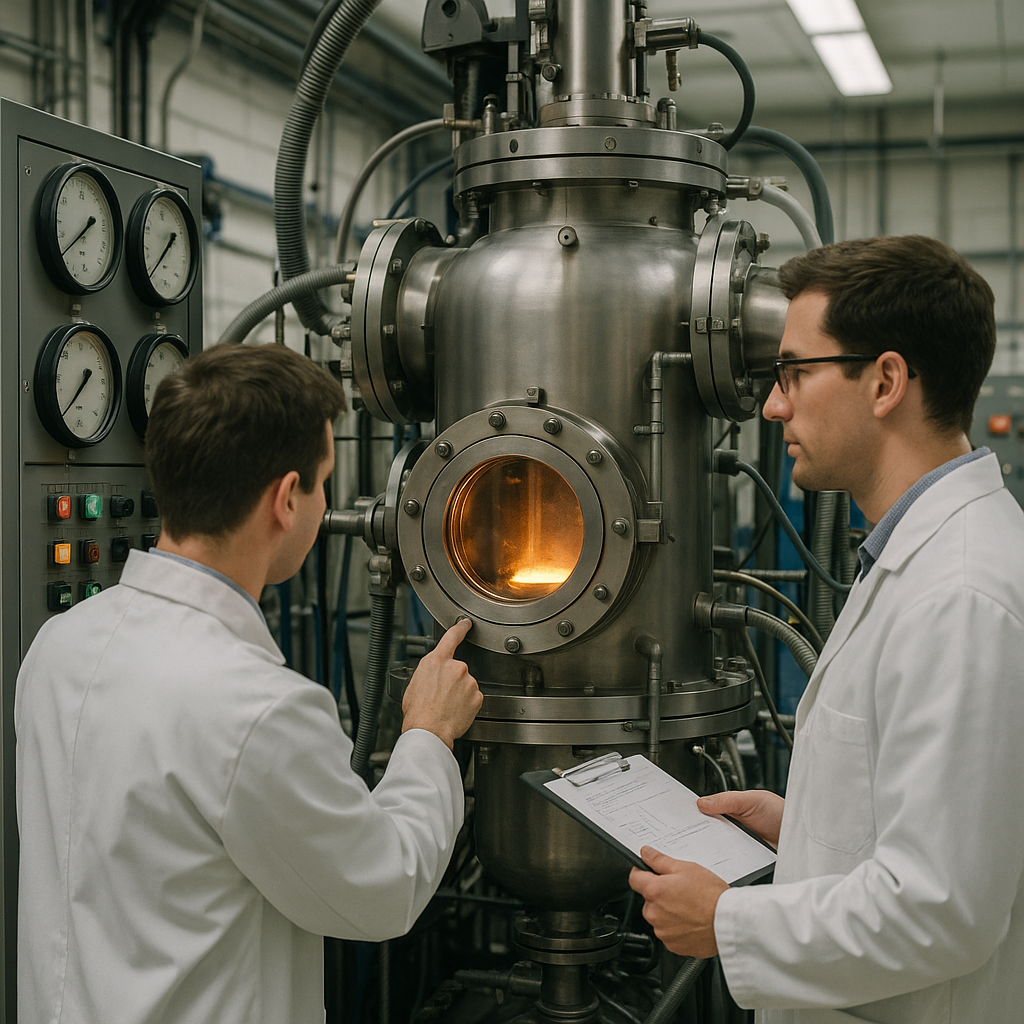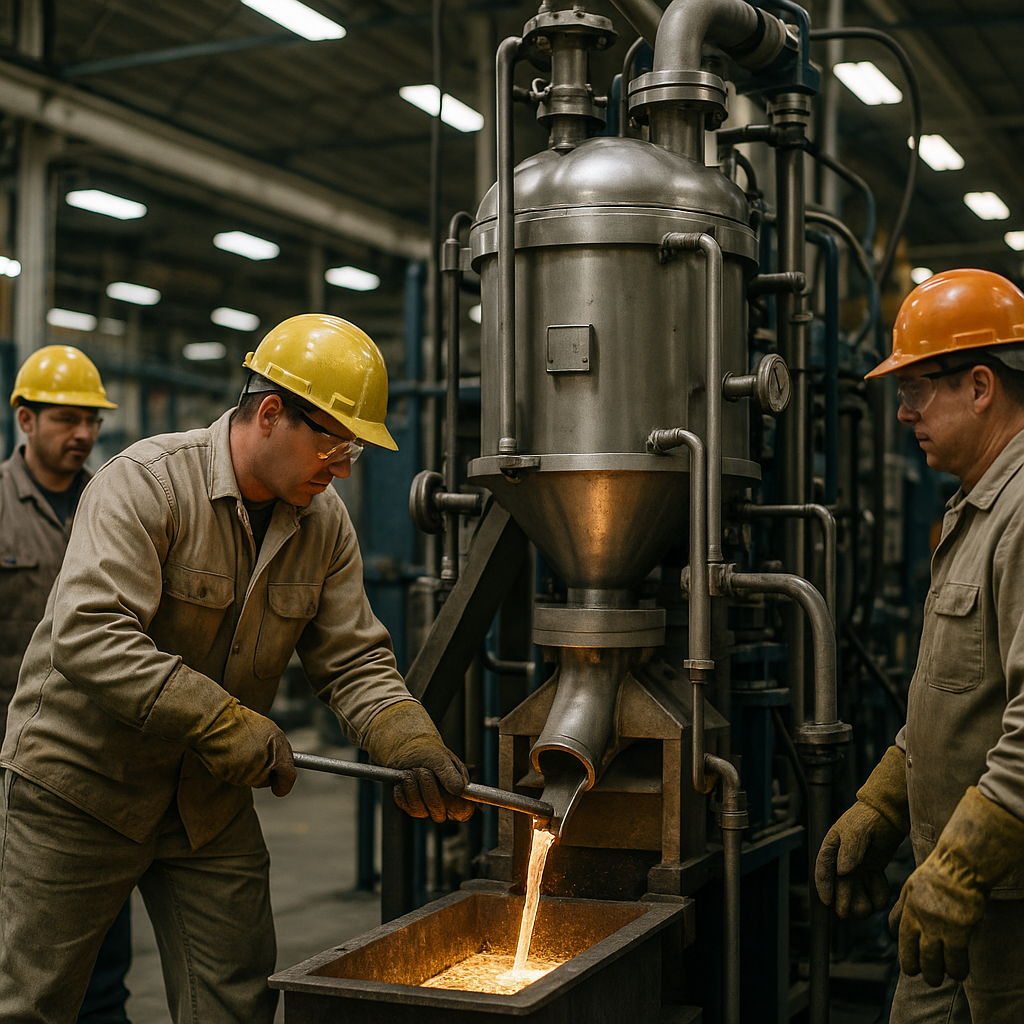5901 Botham Jean Blvd, Dallas, TX 75215
Vacuum Distillation of Metals: Process, Benefits, and Industrial Applications
September 30, 2025Vacuum distillation of metals is a specialized metallurgical process that separates, enriches, and purifies metals in a controlled low-pressure environment. This technique is increasingly important in modern metal recycling and refinement operations. By creating a vacuum within the distillation apparatus, processors separate metals based on their vapor pressures at significantly lower temperatures than traditional atmospheric methods.
Vacuum distillation works by exploiting the fact that different metals evaporate at different rates under reduced pressure. When pressure is lowered inside a distillation chamber, the boiling points of metals drop considerably. This allows volatile metals to vaporize while less volatile metals remain in their liquid or solid state.
Vacuum distillation is particularly valuable in metal processing due to its environmental benefits, operational efficiency, and product purity. The process uses less energy than conventional high-temperature separation techniques while producing minimal waste. For industries dealing with precious or specialized metals, this method offers a practical approach to achieving high-purity results without excessive heat or chemical treatments.
How Does the Vacuum Distillation Process Work for Metals?

The vacuum distillation process for metal separation begins with a specialized distillation unit containing a mixture of metals. Unlike traditional methods requiring extreme temperatures, vacuum distillation uses reduced pressure for efficient separation.
Central to this process is the manipulation of vapor pressure. When the chamber pressure is significantly lowered below atmospheric levels, metals with lower boiling points evaporate at much lower temperatures than usual.
Selective evaporation occurs because each metal has a distinct vapor pressure at any given temperature. When system pressure falls below a metal’s vapor pressure, it begins to evaporate while others remain liquid.
For instance, separating magnesium from aluminum in alloys is aided by the vacuum environment, enabling magnesium to evaporate far below its standard boiling point of 1,090°C. This reduces thermal damage and conserves energy.
Vaporized metal then travels through the distillation column to a condenser. Here, it cools and solidifies for collection in a separate receiving vessel, with condensation carefully managed to preserve purity.
The remaining metal mixture, now richer in less volatile metals, stays in the original unit. By adjusting temperature and pressure, operators can control which metals evaporate at specific process stages.
This method yields exceptional separation efficiency, achieving purity levels exceeding 99.9% for many metals. Vacuum distillation is especially useful for producing high-grade metals for electronics, aerospace, and specialized alloys.
What Are the Key Advantages of Vacuum Distillation for Metal Purification?
Vacuum distillation stands out as a superior method for metal purification in the recycling industry. This technique operates by reducing the pressure within the distillation apparatus, significantly lowering the temperature required to separate metals. The process creates a controlled environment where metals with different boiling points can be effectively separated without compromising their integrity.
One of the primary advantages of vacuum distillation is its ability to handle metals with high boiling points. When processing scrap metal with volatile elements like zinc, magnesium, or cadmium alongside less volatile metals, the vacuum environment allows for selective evaporation. This enables recyclers to process complex metal mixtures that would otherwise be difficult to separate using conventional methods.
The energy efficiency of vacuum distillation represents a major economic benefit for recycling operations. By operating at lower temperatures than atmospheric distillation, the process requires substantially less energy to achieve the same separation results. For instance, aluminum recycling facilities using vacuum distillation typically report energy consumption reductions of 30-40% compared to traditional refining techniques.
High-purity output is another significant advantage of this process. Vacuum distillation can produce metals with purity levels exceeding 99.9% in many cases. The reduced pressure environment minimizes contamination risks and allows for precise separation of metal components. This is particularly valuable when recycling precious metals or producing materials for high-specification applications in electronics or aerospace industries.
The environmental benefits of vacuum distillation are notable. Unlike some conventional metal purification techniques that may generate toxic gases or effluents, vacuum distillation is a clean process. It produces minimal waste streams and doesn’t require hazardous chemicals for separation. This environmentally friendly profile helps recycling facilities comply with increasingly stringent environmental regulations.
From a practical operations perspective, vacuum distillation offers improved control over the purification process. The reduced operating temperature minimizes thermal degradation of metals and prevents unwanted side reactions that could compromise product quality. The technology also allows for continuous processing, enhancing production efficiency and consistency.
For the aluminum recycling industry specifically, vacuum distillation has proven transformative. It efficiently removes magnesium, zinc, and other volatile metals from aluminum scrap, producing high-grade recycled aluminum suitable for demanding applications. This allows recyclers to process a wider range of aluminum scrap sources while still meeting stringent quality specifications.
What Are the Industrial Applications of Metal Vacuum Distillation?

Vacuum distillation is crucial in metal processing industries due to its ability to separate, purify, and recover metals in a controlled, low-pressure environment. The technique takes advantage of the differences in saturated vapor pressure between metals for thorough purification without introducing environmental contaminants.
For high-purity metal production, vacuum distillation effectively removes trace impurities that could compromise performance. Aluminum manufacturers achieve purities exceeding 99.999%, vital for aerospace and defense applications where material integrity is essential. This process heats aluminum-containing alloys, often with magnesium impurities, to around 1373K under vacuum conditions, where magnesium vaporizes while aluminum remains.
The recycling industry has adopted vacuum distillation for processing complex scrap metal streams sustainably. Unlike traditional three-layer electrolysis refining methods, vacuum distillation avoids using chemical fluxes and doesn’t produce harmful by-products. This makes it especially valuable for aluminum recycling operations, achieving direct recovery efficiencies of up to 98% while generating minimal waste. It is particularly effective at separating aluminum from magnesium in recycled materials.
Semiconductor manufacturers rely on ultra-high purity metals for reliable electronic components. Vacuum distillation yields germanium and tellurium with impurity levels below one part per billion, crucial for high-performance semiconductor devices. The technique’s precise separations at the atomic level are indispensable in this industry focused on accuracy.
Precious metal refiners use vacuum distillation to separate valuable metals from complex mixtures. Tellurium, often found in lead anode slime from copper electrolysis, can be effectively recovered through vacuum gasification-directional condensation. The process also separates gold, silver, and other precious metals from alloys with recovery rates exceeding 99%.
The treatment of non-ferrous metal waste is another critical area of application. Vacuum distillation processes complex waste streams from manufacturing, including tin refining sulfur slag and waste photovoltaic panels. The technology recovers cadmium, tellurium, and other valuable metals from these sources with minimal environmental impact, meeting the demand for sustainable metallurgical practices.
Recent innovations in vacuum distillation technology include multistage distillation systems that enhance separation efficiency, electromagnetic field assistance that improves metal suspension and heat transfer, and computational modeling that optimizes process parameters. These advancements continue to broaden the scope of metals effectively processed using this technique.
The economic benefits of vacuum distillation extend beyond metal recovery. It typically features shorter production cycles, requires less labor, and consumes less energy than conventional refining methods. For aluminum processing, vacuum distillation completes purification in about three days, significantly reducing operational costs while improving product quality.
Conclusion: The Future of Vacuum Distillation in Metal Processing
Vacuum distillation is a transformative technology in modern metallurgy, offering significant advantages over conventional refining methods. Its ability to separate and purify metals based on vapor pressure differences enables more efficient recovery of valuable materials while operating at lower temperatures than traditional processes. The technology excels environmentally due to reduced energy consumption, minimal waste generation, and the absence of harmful emissions typically associated with conventional metal processing.
As industries shift toward greater sustainability and resource efficiency, vacuum distillation is poised to become increasingly vital in metal processing. The rising demand for high-purity metals in electronics, renewable energy technologies, and advanced materials will continue to drive the adoption of this versatile separation method. Additionally, as regulatory frameworks increasingly emphasize environmentally responsible manufacturing, the clean operation of vacuum distillation offers a compelling advantage over traditional processes.
For your metal recycling and purification needs, contact Okon Recycling at 214-717-4083.
